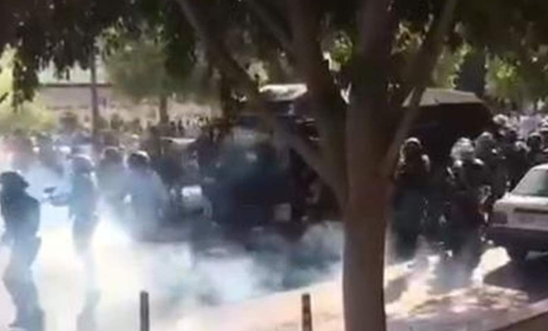
Press releases
Iran: protester death toll reaches at least 143

Verified videos show security forces deliberately shooting unarmed protesters at close range
Reports of bodies not being returned to families, of the injured being removed from hospitals, and of families even charged for cost of bullet that killed loved ones
‘The international community’s cautious and muted response to the unlawful killing of protesters is woefully inadequate’ - Philip Luther
According to credible reports received by Amnesty International, the death toll of protesters killed by the Iranian security forces has reached at least 143 since demonstrations broke out on 15 November.
The deaths have resulted almost entirely from the intentional use of firearms by the security forces - though one man was reported to have died after inhaling tear gas and another after being beaten.
Amnesty believes that the death toll is significantly higher and is continuing to investigate.
Though the UN High Commissioner for Human Rights, the EU and a number of countries have condemned what they described as the apparent use of excessive force, these responses have failed to explicitly acknowledge the use of lethal force to kill protesters, despite mounting evidence.
Horrific accounts from eyewitnesses and victims’ relatives on the ground, information gathered from human rights activists and journalists outside Iran, and extensive video footage analysed by Amnesty’s Digital Verification Corps, provide clear evidence that the Iranian security forces have been intentionally using firearms against unarmed protesters who posed no threat to life.
Verified videos show security forces deliberately shooting unarmed protesters at close range. In some cases, protesters were shot while running away and clearly posing no threat to security forces. Other videos show the security forces shooting towards protesters from the rooftops of state buildings, including a justice department building. Security forces responsible for the crackdown include Iran’s police force, the Revolutionary Guards, and plainclothes agents from the Basij paramilitary force.
Under international law, security forces may only resort to the use of lethal force when strictly unavoidable to protect against imminent threat of death or serious injury. Even if a small minority of protesters resort to violence, security forces must always exercise restraint and use no more force than is strictly necessary, proportionate and lawful in response to the violence they are facing.
Philip Luther, Amnesty International’s Middle East Research and Advocacy Director, said:
“The rising death toll is an alarming indication of just how ruthless the treatment of unarmed protesters has been by the Iranian authorities.
“The international community’s cautious and muted response to the unlawful killing of protesters is woefully inadequate.
“They must condemn these killings in the strongest possible terms and describe these events for what they are - the deadly and wholly unwarranted use of force to crush dissent.”
Bodies not returned to families, and injured removed from hospitals
Amnesty has also received reports that the Iranian authorities have moving injured protesters from hospitals to detention facilities, putting their lives at risk by denying them potentially life-saving medical care.
Amnesty has also received information indicating that, in many cases, the Iranian authorities have refused to return victims’ bodies to their families and, in some cases, the security forces have removed dead bodies from morgues and transferred them to unknown locations.
There are also shocking reports that, when the authorities have returned victims’ bodies to their families, they have demanded payment citing several reasons, including the cost of the bullet that killed their loved one, or compensation for property destroyed during the protests. These allegations have been denied by at least one official in Khuzestan province.
Meanwhile, in a pattern consistent with previous protester killings in Iran, the authorities have threatened victims’ families with arrest if they hold funerals for their loved ones or speak to members of the media.
City and province breakdown of deaths
Below is a breakdown, by city and province, of the 143 deaths reported so far to Amnesty. Amnesty obtained the information from reports whose credibility and reliability it has ascertained by interviewing journalists and human rights activists involved in gathering them. It has then crosschecked the information.
Alborz province: 9
East Azerbaijan province: 1
Esfahan province: 7
Fars province: 15
Kerman province: 1
Kermanshah province: 34
Khuzestan province: 40
Kurdistan province: 12
Tehran province: 20
West Azerbaijan province: 4